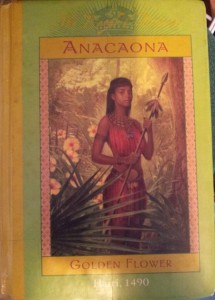
I picked up this book from the library the other day in the hopes of doing a Mondayitis from it, I may still do a Mondayitis tomorrow as I think it quite fitting for such a culture but I wanted to write a few more words about it.
I picked it up solely on the description on the back, the name and cover, nothing more. I knew nothing about it and was incredibly surprised and moved by the contents. It is the story of Anacaona, tribal chieftess in Haiti in 1490. She wasn’t actually a chieftess, or Cacica as the word really is, by herself but ruled the tribe Maguana with her husband, Caonabo. Her brother, Bohechío, and Caonabo were two of the five highest Caciques in Ayiti when Christopher Columbus visited in 1496, with Bohechío and Anacaona being equal negotiators, so she had really high status at that time and was actually brought up with the idea that either her or her brother would rule Xaragua when the current chief died, it turned out to be Bohechío as Anacaona married.
When I started reading this book I had no idea I was reading about Haiti royalty and no idea the book would be so moving or so well written. It’s written in diary style as if Anacaona’s pictures have been translated to English and it’s very nicely done. About a third of the way through the book I suddenly thought to google Anacaona and was astounded by what I found. I now have a hankering to visit.
After I’d googled and realised this was a true story I’m reading the part about the rain and hurricane (a word that comes directly from their language) and my mind is taken immediately back to 2012 and Hurricane Sandy. This is the area that took the main brunt of Hurricane Sandy before moving onto the States, the people still hadn’t recovered from the earthquake in 2010 that devastated the region. Two years later I’m sure they still haven’t recovered as it’s a long journey.
Back to the book. Danticat uses the diary technique to good advantage, we get enough detail to get a good picture of how things must have happened and to understand Anacaona and why she married and how she was trained to be a ruler but not too much detail to be overwhelmed. There is fighting and death but not too much detail about either so preteens would be fine with it. I finished it last night and went to sleep feeling as if I wanted to know more about the culture and being very pleased some descendents of Anacaona’s people may still be alive today. I also felt honoured to have been able to read about Anacaona and her people, I feel she was a wonderful person and wish she was alive today (challenging as she’d be very old but so what). I do hope they revive as much as they can of the culture and educate us.

